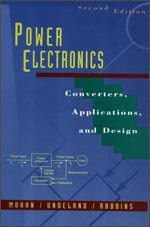
Author(s): Ned Mohan, Tore M. Undeland, William P. Robbins
Publisher: John Wiley & Sons; 2 edition
Date : 1995
Cohesive presentation of power electronics fundamentals for applications and design in the power range of 500 kW or less. Describes a variety of practical and emerging power electronic converters made feasible by the new generation of power semiconductor devices. This revised edition includes an expanded discussion of diode rectifiers and thyristor converters as well as new chapters on heat sinks, magnetic components which present a step-by-step design approach and a computer simulation of power electronics which introduces numerical techniques and commonly used simulation packages such as PSpice, MATLAB and EMTP. Contains a significantly expanded set of end-of-chapter problems.
Reviews
Summary: Had What I needed.
Rating: 5
Although a little light on full converter schematics, this textbook contained excellent descriptions of converter building blocks and semiconductor device physics. It is excellent that it came with a simulator program too.
Summary: Great book in power electronics
Rating: 5
There is a ton of information on three-phase power electronics, converters, and etc. I feel guilty for not being able (time wise) to read all of it.
Summary: Good overview ... a bit thin on some subjects
Rating: 3
Good power electronics textbook. I use it for my power electronics course at Worcester Polytechnic Institute. It covers a lot of material well, including switching power converters, thermal and magnetics design. It's a bit thin in some important subjects, such as current mode control.
Marc T. Thompson, Ph.D.
CD CONTENTS
This CD contains four folders containing materials which support and enhance the book Power Electronics: Converters, Applications, and Design by Ned Mohan, Tore Undeland, and William Robbins. The four folders are:
1. Chapter Slides
2. New Problems
3. PSpice-based Examples
4. Transformer & Inductor Design.
Each folder has its own ReadMe document which lists in detail what is in the folder and any specific requirements for using the material in that folder. These ReadMe files should be examined first before using the materials in the specific folder.
The Chapter Slides folder contains two subfolders, one entitled Chapter slides in PDF and the other entitled Chapter Slides in PowerPoint. Each subfolder contains the same information but one folder contains PDF files while the other has the same files in PowerPoint format. Within each folder are 30 separate files, one for each chapter of the book which contains all the figures in that chapter, usually one figure per slide with a few bulleted comments. The slides can be used in a variety of ways such as preparing lectures or for self-study and review.
The New Problems folder contains over 100 new problems which can be used for problem assignments in a class, as example problems in lectures, or for additional problem solving practice. There are four files in the folder, New Problems Chptrs 1-18 in both Word and PDF format and New Problems Chptrs 19-30 in Word and PDF format. Within each file, the problems are organized on a chapter-by-chapter basis.
The PSpice-based examples folder contains 27 different power electronic circuit examples which are ready to run. Each example covers a different topic. Two PDF files are also contained in the folder: one discusses how to setup and use the examples and the other shows the circuit schematic of each example and several suggested problems or questions to be answered using PSpice.
The Transformer & Inductor Design folder contains two Excel spreadsheets, one for designing inductors and one for designing transformers which are used in power electronic converters. These spreadsheets automate the design process as described in Chapter 30 of the book and they contain detailed information on most of the commonly used cores. In addition to the ReadMe files, there is a PowerPoint file entitled Magnetic Design Method which explains in detail how the spreadsheet is organized and various ways in which it might be utilized.
The book has a website at: http://www.wiley.com/college/mohan. A variety of information will be posted there including FAQs and updates to CD files.
Download
Password: www.freebookspot.com
No comments:
Post a Comment